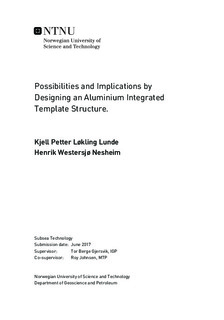Possibilities and Implications by Designing an Aluminium Integrated Template Structure.
Master thesis
Permanent lenke
http://hdl.handle.net/11250/2454127Utgivelsesdato
2017Metadata
Vis full innførselSamlinger
Sammendrag
Steel has historically been the governing material for use in subsea applications. This master thesis looks into the possibility of using aluminium rather than steel in subsea structures. A four-slots integrated template structure installed on the Gjøa field in the Norwegian Sea is used as design basis. The use of aluminium represents a lighter structure with a potential in reducing life cycle cost. The aluminium alloys 5083 and 6082 are the only ones approved for structural seawater applications by the NORSOK M-121 standard, where H116 and T6 are the strongest approved tempers, respectively. However, material properties has to be fully understood in order to utilize aluminium in a subsea environment. Especially with respect to corrosion behaviour, mechanical properties and joining methods. Bolting, metal inert gas and friction stir welding are identified as preferred joining methods.
The structure is redesigned utilizing appropriate alloys and joining methods. Load simulations are subsequently performed using finite element method, where the structure withstands design loads defined by industry standards with acceptable results. The main loadtypes are drilling, trawling, tie-in and weight of equipment installed on the integrated template structure.
The utilization of aluminium in subsea structures looks very promising for the integratedtemplate structure, although there is a need for more research, especially with respect tocorrosion of aluminium buried in soil. A total weight reduction of 36% is achieved by utilizing aluminium. Total cost for the aluminium made structure is competitive to steel, where aluminium fabrication cost is the decisive factor.
